October 31, 2009, Oceanside, California, USA
Questions
and
e-mail interview by Bob Green
Photos courtesy of Wes Humpston
1. When did you start riding bellyboards?
In the late 60's, my friend Kevin Kaiser started on a Stub
Vector and I rode a Concave Vector about the same time way back in
the late 60s and then started making wooden boards with
handles and fins and would draw and spray paint them. We
grew up in Santa Monica rode POP (Pacific Ocean Park) and all up
the coast, looking for fast hollow waves.
We started making foam boards, did the art with spray paint, airbrush
and sharpies. We kept the handles and went from 2 fins to 3 and 4
fins. Many times we did whatever was the newest design with
surfboards like 3 fins or the double concave in the tail like the
bonzer boards.
2.
Were
you and Kevin riding the vectors stand-up or prone? What
inspired you to ride these boards prone?
Like bellyboards with both hands on the nose
like this photo.
3.
Had
you ridden stand-up before getting into these boards? Were your
boards shorter than regular stand-up boards?
Yeah, I had tried stand-up a few times, but
after body surfing and riding surf mats in the summer and bellyboards just
felt
more natural I guess.
4.
Why
did you switch to wood? Where did the design inspiration come from?
It was cheap and easy. Also, there was another belly boarder, Harold
Rothstein's older brother (Drubart aka Andy Rothstein), riding on big
days at POP that ripped and was in the tube for days. He rode a
wooden Pipo with no fins with a handle that was much
flatter to the
board. Harold
told us to get marine plywood and we did then
we could make what ever template/shape we wanted we put handles on the
nose, two fins and painted and drew all over them when we had the
time... This was all about early 1970. Then a few years later we started to use
foam.
|
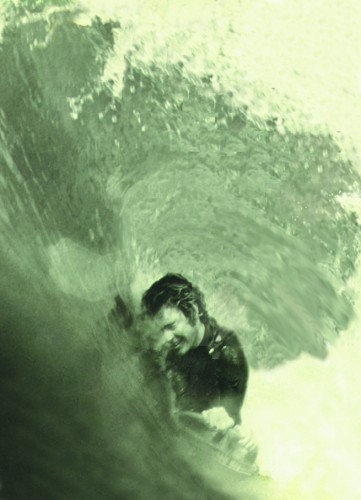 Wes on the wooden paipo, ca. early 1970s.
Wes on the wooden paipo, ca. early 1970s.
|
5.
Why
did you switch back to foam?
We made many wooden boards but they didn't
float too well so we went to foam kneeboard blanks and wooden handles
that were glassed on like fins.
6. Were there many other bellyboarders around at the
time? If this a tight knit crew who knew each other well and surfed
together what was the reaction of other surfers to so many
bellyboarders? When you traveled did you see other bellyboarders?
Yeah, slowly people/friends started getting
into it and there were 15 to maybe 20 guys into it and some made
there own boards.
7.
What
attracted you to bellyboards? What was your approach to riding
waves on a belly board? Was this similar to how other guys rode
bellyboards?
I think cuz I could ride hollow waves, on
hollow steep fast days. Kev and I would see surfers getting pitched on
waves we were making. Also, you can ride so far back in the
tube, we would be in a tube and have a guy drop in in front of us
screaming about the tube, and we would just say, "Yeah, we were behind
you!
Hahahahaha!!!"
8. You mentioned you rode boards that reflected the
latest stand-up developments. Any particular designs/fin configurations
work well? Any that you found didn't work?
I don't know if you could say didn't work but
the newer designs would work better.
9. If there was a particular board you preferred what
would be the typical dimensions?
Always the newest because they had the newest
modifications. My newest one Craig Hollingsworth made for me and it's
59 inches long and 22.5 inches wide, and that's in the hips. The board
has three fins and a flat bottom
going into a "V" tail and shallow concaves in the tail with thin hard
rails.
10. How many boards do you think that you made all
up? Who was buying the boards - locals, collectors, people from
around the USA?
I never really kept track of how many --
maybe 15
to 25 wooden boards and a few more of the foam. Kev and I would
each make a board and try to out-do the other a little and then we
would
try the other's board when we got them into the water.
11. Who did what in the construction process?
We each did the whole board from the shaping,
painting, glassing and making the fins and handles.
12. The boards I have seen were very distinctive with
the wooden handles and artwork. Can you tell me about the artwork?
Like
everything else about the boards it was
always evolving. In the beginning we used whatever we could find, pens
and pencils and what ever spray paint we could scrounge up.
Then as we got older and got jobs we started hitting the art store and
for colored pens/sharpies and airbrush paint. I would sketch on the
foam then airbrush and finish with a black sharpie. In the late-60s and
70s there was so much cool art that influenced me growing up.
Examples of Art Work on the Paipos
(click on pics for larger images)
|
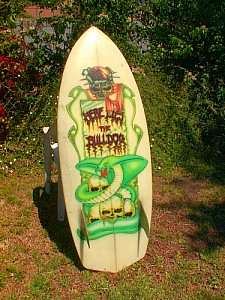 |
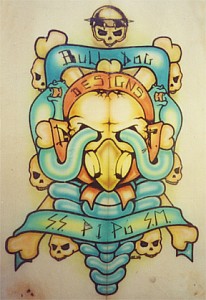 |
13. Did Ho's surf shop play a role in the development of
bellyboarding in the area?
Yeah, I worked there for a few months in 1970.
I
think I was 15 and saw Craig Stecyk spray boards a few times and
that really got me thinking after seeing him working with stencils and
seeing him doing layers of colors, fades and blends and just
things I had never seen before because no one was doing it. It was kind
of a free style spray can art on surfboards. Also,
Skipper showed me how to use a sander and told me the sander was his
tool and he could shape a surfboard with one! Also, I
worked a summer with Kent Sherwood, Jay Adam's dad and we did a lot of
fiberglass and resin work and resin poured into forms kind of stuff.
It was trippy stuff and Kent gave me a Milwaukee Grinder, the first
grinder I ever had.
Bellyboards in back at the Zephyr Shop, ca. 1970-72
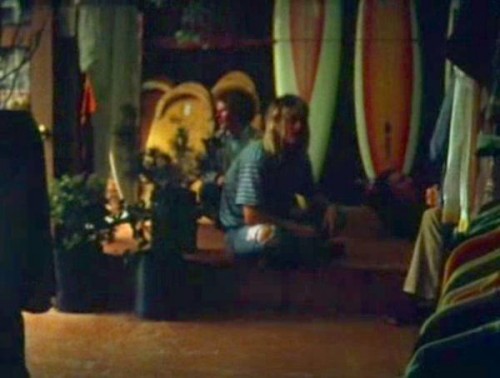
14. Mid-80s is much longer to keep at belly boards. Any
guys still riding the style of boards you were riding?
The first half of the 1980s was great. Took
some
killer trips to Mex with friends in 1983. I think there was one of the
biggest storms to hit SoCal and my brother and I were on the Santa
Monica pier watching giant waves slamming into it and then the end
of the pier fell into the sea. That was rad! I really don't know
if guys are still riding them up there. I moved to San Diego almost 20
years ago for a job with my family and kind of lost touch with
all them guys. A few have died.
15. How did art, skating and surfing go together?
Well to me, I grew up body surfing and riding
surf mats in the summers. Then, I met Kev and a few other guys -- Craig
Hollingsworth, Chris Cahill -- and we got wetsuits and were in the
water almost every day. We loved all the surf art, like Rick Griffin's,
and rock art on posters and PL's Zap Comic art and we would put
that on our Pipo boards then we all started skating in the mid-70s and
it
was just a natural thing to make out own skateboards. A lot of kids did
it at that time cuz it was cheap. A new board was just another
clean canvas to draw and paint on so it was all just kind of an
evolution? The waves are best in the morning in SoCal so the day
would start by hunting for waves and then turned into a skate session.
Kevin and Wes's Quivers
|
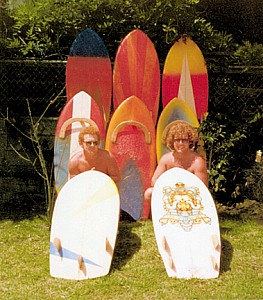
|
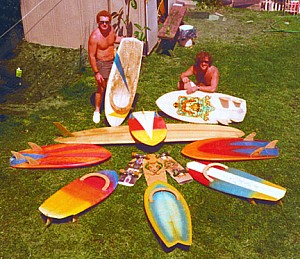
|
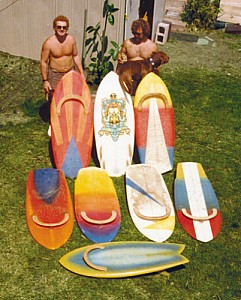
|
The New Boards (ca. 2009)
|
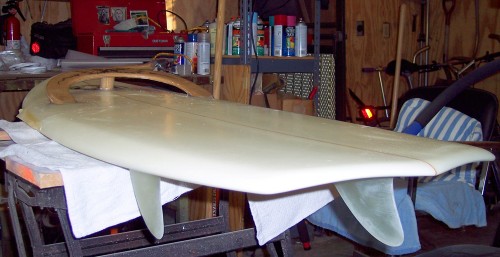

|
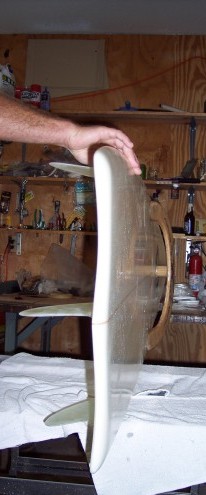 |
Wes Humpston in Kevin's Garage
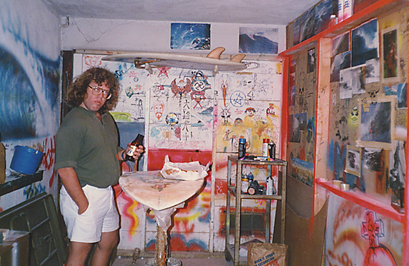
|
|
Other Information:
Wes Humpston's site, http://www.bulldogskates.com/.
|
|